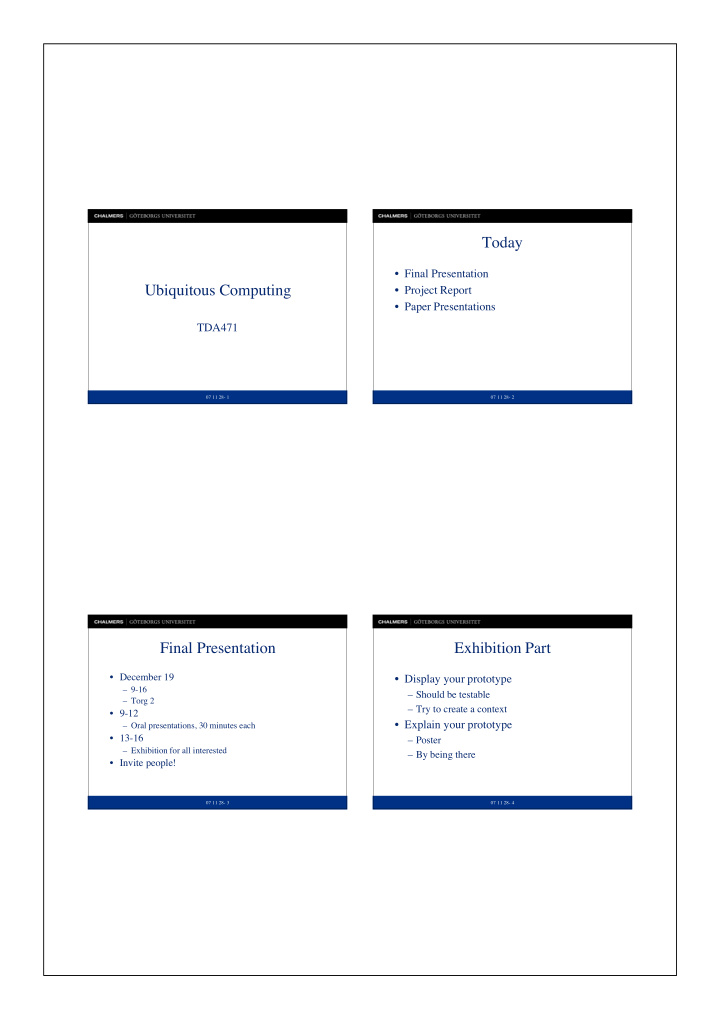



Today • Final Presentation Ubiquitous Computing • Project Report • Paper Presentations TDA471 07 11 28- 1 07 11 28- 2 Final Presentation Exhibition Part • December 19 • Display your prototype – 9-16 – Should be testable – Torg 2 – Try to create a context • 9-12 • Explain your prototype – Oral presentations, 30 minutes each • 13-16 – Poster – Exhibition for all interested – By being there • Invite people! 07 11 28- 3 07 11 28- 4
Project Report Web Site • Two parts • Explain the project for a wide audience • Should contain at least – Web site – Short abstract in Swedish and English – Written report – Description of the project • As a download from web site – Video (if there is one) • Deadline 21/12 – Pictures and/or powerpoint • Course home page contains info – Downloads of source code, technical specifications etc, required to re-create the project. 07 11 28- 5 07 11 28- 6 Web Site Web Site • Must be on Chalmers’ server • Mount in Windows • Path to your space – \\file.chalmers.se\uc07-1 • /chalmers/groups/uc07-1 – \\file.chalmers.se\uc07-1 • /chalmers/groups/uc07-2 • … • … • GUI Tools for remote access • Servers – WinSCP • remote1.studat.chalmers.se – Fugu • remote2.studat.chalmers.se • … 07 11 28- 7 07 11 28- 8
Web Site Written Report • Web site in directory www • Should contain – project concept • Group directory will only appear if you – an introduction to the context of your design, actually request it – main goals of the project, – possible related work, – the design process and critical design decisions made, – how the project was realized, including a description of the technology behind it, 07 11 28- 9 07 11 28- 10 Written report Possible Outline 1. Introduction • Should contain, continued 2. Background – evaluation against goals, 3. Concept – discussion; what worked, what did not, possible 4. Realisation improvements, interesting findings,... 5. Evaluation – conclusion, lessons learned, 6. Related Work – technical documentation, as appendix, 7. Discussion – project plan as appendix. 8. Appendix: Technical documentation and project plan 07 11 28- 11 07 11 28- 12
Possible Outline 2 Papers 1. Introduction • Theme: Place, Space and Context 2. Concept – Re-Place-ing Space: The Roles of Place and 3. Realisation Space in Collaborative Systems 4. Evaluation – The is more to context than location 5. Related Work – Multi-Sensor Context-Awareness in Mobile 6. Discussion Devices and Smart Artefacts 7. Appendix: Technical documentation and project plan 07 11 28- 13 07 11 28- 14 Re-Place-ing Space: The Roles of Place and Context Space in Collaborative Systems • Key point • Published 1996 • Dsign for place not space • CSCW • MUDS • Collaborative environments 07 11 28- 15 07 11 28- 16
Mantra • Space is the opportunity; place is the understood reality – About taking sociological issues into account – Borrow from architecture etc – Implications for design – Minor points, e.g. privacy is not absolute 07 11 28- 17 07 11 28- 18 Place • a place is a space which is invested with understandings of behavioural appropriateness • House - home • Conference Hall - Concert Hall • Community Hall • Out of place - not out of space 07 11 28- 19 07 11 28- 20
Space • Spatiality is important • Shared Knowledge – Relational orientation and reciprocity. – Proximity and action – Partitioning – Presence and awareness 07 11 28- 21 07 11 28- 22 Place is In Space Place in Social Analysis • Places derive from their spatiality • what these analysts point to in human action is the how it is framed not only by spaces, • But also call up cultural understandings but by the pattern of understandings, which help us to frame our behaviour associations and expectations with which they are infused 07 11 28- 23 07 11 28- 24
Place in the Built Environment More Quotes • Place, as we have described it here, is a central • Placeness is created and sustained by concern for architects and urban designers. patterns of use; it's not something we can design in...can design for it • architects and urban designers are concerned not • idea of a sense of place--a communally- simply with designing three-dimensional held sense of appropriate behaviour, and a structures (spaces), but with places for people to be. For them, the idea of place derives from a context for engaging in and interpreting tension between connectedness and distinction action. This is essentially a cultural phenomenon 07 11 28- 25 07 11 28- 26 Space-less places Space-less places • The distinction between ``space'' and ``place'' is • On-line multiplayer games? perhaps most strongly demonstrated by examples • Communities of the emergence of place without notions of • Forums space. Earlier, we introduced the concept of place as space invested with social meaning. The spaces • MUDS can be computational, as well as physical. What • USENET remains is the tension between connectedness and • … distinction which leads to placefulness 07 11 28- 27 07 11 28- 28
Ubiquitous Computing Rubrics for Design • Computation in space • Spaces are not places • Distributed • Places, not spaces, frame appropriate behaviour • Everyware • Places have social meaning • Different media have different spatial • Essence of paper: Must take place into properties. account • Space is the opportunity; place is the • Study and design for actual social understood reality environment 07 11 28- 29 07 11 28- 30 The Rest? Next Week • Influential paper • Discussion seminar • Makes important points • Read the papers – Design for place - not space – There can be places without place • Details about MUDS, Usenet etc somewhat dated • Read in context 07 11 28- 31 07 11 28- 32
Recommend
More recommend